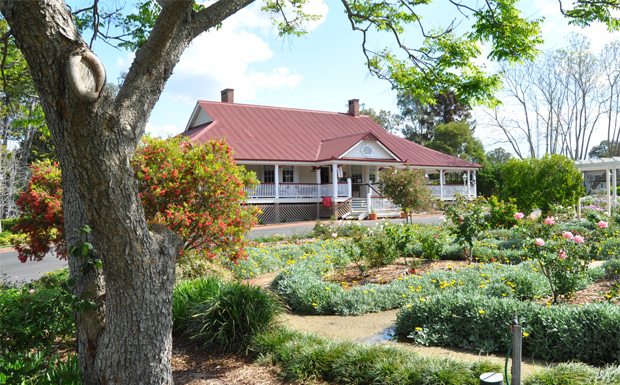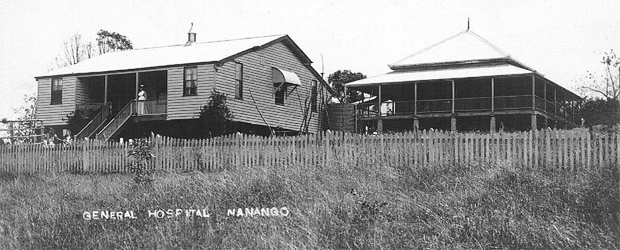
September 12, 2018
Nanango Hospital will be celebrating its 120th anniversary on Saturday with a special fete and display of memorabilia.
Fittingly, the event will be held at the former Ringsfield Maternity Home (better known these days as Ringsfield House).
Nanango Hospital is reported to be the longest operating hospital in Queensland, although over the past two decades it has had to fight off rumours of its imminent closure on several occasions – the latest as recently as 2010.
The fete will be held in the grounds of Ringsfield from 7:00am to 11:30am, and will be followed by a cent auction at Taras Hall from 1:00pm.
All proceeds will go to the Nanango Hospital Auxiliary.
* * *

Nanango Hospital opened its doors 1898 … while Queensland was still a colony.
A year later, a report about staff changes at the establishment, published in the Darling Downs Gazette, captured the mood of the country about the upcoming Federation: “So the die is cast, the word is spoken. Queensland has voted ‘Yes.’ Now then, you anti-federalists, help forward a cause that you cannot now slay, and make United Australia ring with the echoes of your efforts to improve its constitution in practical effects. Work, for the dawn has broken!”
Over the years, raising money and extending services seem to have been the two major concerns for the Nanango Hospital management.
A benefit concert to raise funds for the Hospital, held in July 1904, attracted praise and criticism from the correspondent for the Maryborough Chronicle, Wide Bay and Burnett Advertiser:
“The Snowflakes played to a large and mostly appreciative audience. It is to be regretted that the enjoyment of the evening was somewhat marred by a few noisy individuals who could not appreciate good music and prevented others from doing so, and to my mind it seemed rather strange that the local protector of the peace did not think fit to interfere in the interest of the community at large.”
The next year, fundraising was focussed at the Nanango Races with the Benevolent Handicap, Hospital Handicap, Charity Handicap, Convalescent Handicap and Medical Handicap on the card.
By the start of World War I, the need to extend the facility was becoming apparent.
In April 1914, tenders for the erection of hospital buildings at Nanango were advertised.
Later that year, arrangements were made to hold a bazaar to raise more funds for the project.
Diphtheria stretched resources in 1915, with 26 cases reported at one stage. Three extra nurses and another doctor were despatched from Brisbane to deal with the outbreak.
In June 1917, a public meeting held in the Nanango Shire Hall voted to immediately proceed with improvements to the hospital, including the erection of two extra wards and an operating theatre, at a cost of £1500.
The following year, the Hospital AGM was told money for the improvements – which had now been costed at £1863 – was available. Revenue for the year was £1039, up from £749 the previous year. Expenditure was also up, £940, against £674. “About half the 94 patients treated were received from district centres.”
Fundraising also concentrated attention during the 1920s.
In June 1925, a plain and fancy dress ball was held at Taras Hall to aid the hospital.
In 1928, the hospital committee was welcoming the arrival of the “new electric light” as well as a £30/6/11 donation from the Maidenwell Campdraft committee.
Not long afterwards, a State Government grant ensured a septic system was installed at the hospital.
A bigger problem loomed for Nanango residents in the 1930s, with rumours the independent Nanango Hospital could come under the control of a District Board.
In May 1930, the Nanango Hospital Committee president (Mr R.H. Robinson) declared that Nanango Hospital had maintained and improved itself over the past 25 years: “All they asked was to be left alone”.
The dreaded day was obviously delayed as by the end of the 1930s, the committee was again turning its attention to the need for expansion.
In 1938, the “urgent necessity” of another 12 beds was pressed.
A report in the Brisbane Telegraph in January 1939 again noted the “pressing need” for increased accommodation at the hospital as seven patients had been unable to obtain admission and several others had to wait for vacant beds.
The Health Minister advised there were no funds available and the hospital committee said its hands were tied “owing to the lack of sufficient finance”.
By 1947 the fight for local control had been lost.
Nanango Hospital was now under the control of the Kingaroy Hospitals Board which was drawing up specifications for additions and renovations at Nanango Hospital and the Ringsfield Maternity Home, estimated to cost £4240.
These days, Nanango Hospital is part of the much larger Darling Downs Hospital and Health Service, which controls all South Burnett hospitals.
























It would be good to have access to the names of those on the Board in those very early days.